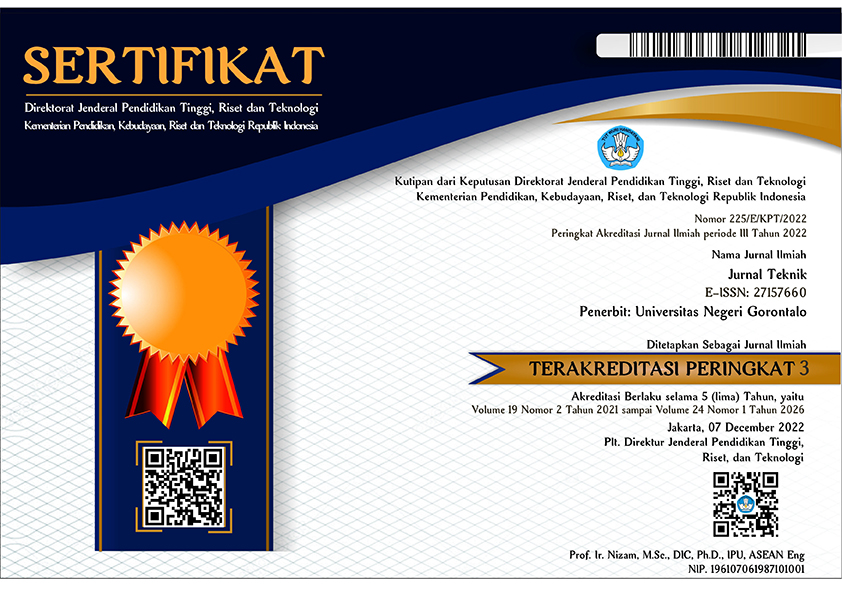Efisiensi Pengolahan Air Limbah Domestik pada IPAL Komunal Di Kabupaten Bone Bolango
Abstract
Waste water needs to be managed properly based on its characteristics to reduce the levels of contaminants contained therein. Communal IPAL or Waste Water Treatment Plants (WWTP) is a centralized wastewater treatment system. Several Communal WWTPs in Bone Bolango Regency have been built, but monitoring is rarely carried out. The purpose of this research was to determine the processing efficiency of communal WWTPs in Kabila District (Dutohe Barat Village and Tanggilingo Village), and Tilongkabila District (Butu Village and Iloheluma Village). The parameters measured were Total Suspended Solid (TSS), Biological Oxygen Demand (BOD), Chemical Oxygen Demand (COD), Total Coliform, Ammonia, and fatty oil tests from inlet and outlet water samples from WWTP. The values obtained are then compared with the quality standards based on the Indonesian National Standard (SNI) 6989.59:2008 concerning Water and Wastewater. The research method uses non-experimental with a quantitative descriptive approach. Sampling using a purposive sampling technique. Based on the results of observations, it was found that there were differences in the results of the efficiency of domestic wastewater treatment, namely the highest TSS removal efficiency in Butu Village (82.9); total coliform in all locations (0); the highest removal in efficiency values were in Iloheluma Village, namely BOD (100), Ammonia (86.95), COD (65.53) and fatty oil efficiency values (98.11) in Tanggilingo Village. The results of this research can be used as a reference for the Regional Government of Bone Bolango Regency to improve the Communal WWTP sustainably to overcome environmental pollution.
Downloads
References
Age, S. P., Suleman, R., & Ali, I. H. (2022). IPAL komunal dalam mengolah limbah rumah tangga di Desa Dutohe Barat. PengabdianMu: Jurnal Ilmiah Pengabdian Kepada Masyarakat, 7(1), 39-44. https://doi.org/10.33084/pengabdianmu.v7i1.2285.
Duma, A. T., Mangangka, I. R., & Legrans, R. R. I. (2022). Evaluasi kinerja dan operasional instalasi pengolahan air limbah komunal di Kelurahan Girian Indah Kecamatan Girian Kota Bitung. Tekno, 20(1), 1-12. https://doi.org/https://ejournal.unsrat.ac.id/v3/index.php/tekno/article/view/44177.
Kemenkes RI. 2011. Pedoman pelaksana jaminan kesehatan masyarakat. Jakarta.
Kurnianingtyas, E., Prasetya, A., & Yuliansyah, A. T. (2020). Kajian kinerja sistem instalasi pengolahan air limbah (IPAL) komunal (Studi Kasus: IPAL komunal Kalisong, Kelurahan Sembung, Kecamatan Tulungagung, Kabupaten Tulungagung, Jawa Timur). Media Ilmiah Teknik Lingkungan (MITL), 5(1), 62-70. https://doi.org/https://doi.org/10.33084/mitl.v5i1.1372.
Lumunon, E. I., Riogilang, H., & Supit, C. J. (2021). Evaluasi kinerja instalasi pengolahan air limbah komunal Kiniar di Kota Tondano. Tekno, 19(77), 67-76. https://ejournal.unsrat.ac.id.
Maharani, A. A., Utomo, K. P., & Kadaria, U. (2023). Kesediaan menggunakan layanan oleh penduduk terhadap fasilitas sistem pengelolaan air limbah domestik terpusat (SPALD-T) Perumahan Kosgoro Permai. Jurnal Teknologi Lingkungan Lahan Basah 11(1),50-55. https://doi.org/https://jurnal.untan.ac.id/index.php/jmtluntan/article/view/58766.
Mahendra Paksi, Tetuko, P., & Subekti, R. (2022). Implementasi program pengelolaan limbah rumah tangga domestik di Kelurahan Danukusuman Kota Surakarta. Jurnal Komunitas Yustisia, 5(3), 330-342. https://doi.org/10.23887/jatayu.v5i3.55432.
Nilandita, W., Pribadi, A., Nengse, S., Auvaria, S. W., & Nurmaningsih, D. R. (2019). Studi keberlanjutan IPAL komunal di Kota Surabaya (Studi Kasus di RT 02 RW 12 Kelurahan Bendul Merisi Kota Surabaya). Al-Ard: Jurnal Teknik Lingkungan, 4(2), 46-54. https://doi.org/10.29080/alard.v4i2.484.
Permen LHK no.68 Tahun 2016. Baku mutu air limbah domestik.
Putri, N. M., & Hardiansyah, F. (2022). Efektivitas penerapan teknologi Ppada IPAL komunal ditinjau dari parameter BOD, COD, dan TSS. Jurnal Teknik Pengairan, 13(2), 183–194. https://doi.org/10.21776/ub.pengairan.2022.013.02.05.
Rahma, A. N., & Purwanti, I. F. (2021). Sistem pengelolaan air limbah domestik kecamatan kota, Kota Kediri. Jurnal Teknik ITS, 9(2), 231–236. https://doi.org/10.12962/j23373539.v9i2.56924.
Ratnawati, R., & Ulfah, S. L. (2020). Pengolahan air limbah domestik menggunakan biosand filter. Jurnal Ilmu Lingkungan, 18(1), 8-14. https://doi.org/10.14710/jil.18.1.8-14.
Rochyani, N., Utpalasari, R. L., & Dahliana, I. (2020). Analisis hasil konversi eco enzyme menggunakan nenas (Ananas comosus ) dan pepaya (Carica papaya L.). Jurnal Redoks, 5(2), 135. https://doi.org/10.31851/redoks.v5i2.5060.
Rophi, A. H. (2022). Analisis mutu air secara mikrobiologi pada perlindungan mata air di Kelurahan Sentani Kota Distrik Sentani Kota Kabupaten Jayapura. Bio-Lectura : Jurnal Pendidikan Biologi, 9(1), 42-54. https://doi.org/10.31849/bl.v9i1.9257
Sahrul, F.A. (2023). Penerapan sanksi administrasi terhadap pelanggaran baku mutu air limbah sebagai instrumen penanggulangan kerusakan lingkungan hidup. Mandalika Law Journal. 1(1), 40-52. https://doi.org/http://ojs.cahayamandalika.com/index.php/mlj/article/view/1546.
Saputri, D., Marendra, F., Yuliansyah, A. T., & Prasetya, I. A. A. P. (2021). Evaluasi aspek teknis dan lingkungan instalasi pengolahan air limbah (IPAL) komunal di Kabupaten Sleman Yogyakarta. Jurnal Rekayasa Proses, 15(1), 71. https://doi.org/10.22146/jrekpros.65833.
Some, S., Mondal, R., Mitra, D., Jain, D., Verma, D., & Das, S. (2021). Microbial pollution of water with special reference to coliform bacteria and their nexus with environment. Energy Nexus, 1(July), 100008. https://doi.org/10.1016/j.nexus.2021.100008.
Sudaryono. (2021). Metodologi penelitian (ke-4). PT Raja Grafindo Persada.
Standar Nasional Indonesia (SNI) 6989.59:2008 . Air dan air limbah bagian 59 metoda pengambilan contoh air limbah.
Suryananda, T. D., & Yudhawati, R. (2021). Association of serum KL-6 levels on COVID-19 severity: A cross-sectional study design with purposive sampling. Annals of Medicine and Surgery, 69(6), 102673. https://doi.org/10.1016/j.amsu.2021.102673.
Turangan, K. A., Mangangka, I. R., & Legrans, R. R. I. (2021). Tinjauan kinerja instalasi pengolahan air limbah metode biofilter di Kelurahan Malendeng Kecamatan Paal 2 Kota Manado. Jurnal Tekno, 19(77), 47-55.
Copyright (c) 2023 dewi baderan, Priwanti Junita Ekwanto, Marini Susanti Hamidun (Author)

This work is licensed under a Creative Commons Attribution-ShareAlike 4.0 International License.













